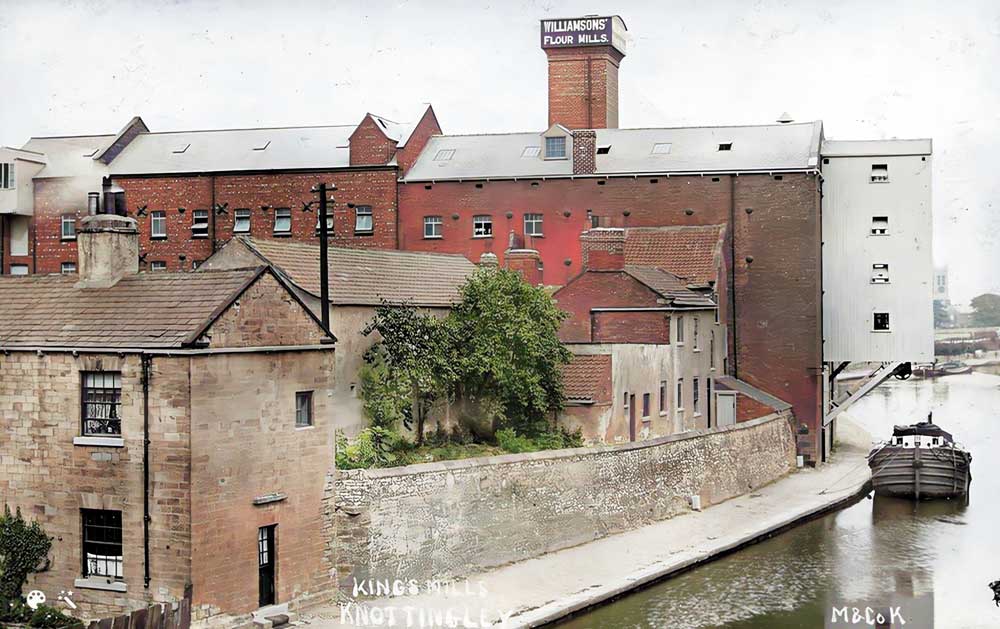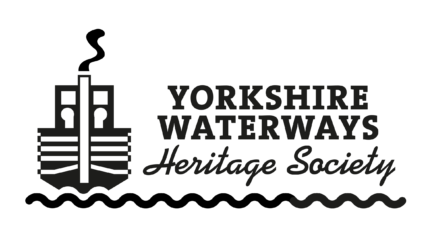In 1980, Nellie Gale nee Scott, the daughter of a busy Knottingley waterman, recalled her childhood memories from before the Great War describing school days and accompanying her parents on working trips by keel towed along the Humber to Hull.
The following extract has been taken from Nellie’s lengthier article Tug to Tug or The Reminiscences of a Water Baby, believed to have been published by the now defunct Knottingley District Civic Society. Nellie’s article was brought to the attention of the Yorkshire Waterways Heritage Society editor, David Scrimgeour, by waterways historian Ron Gosney of Knottingley and its importance as a fascinating educational and entertaining historical record was immediately recognised. Apart from the above, nothing else is known about the circumstances which led to its original creation.
While Nellie Gale died in 1985 at the age of 83 years, this Society is fully aware that her work remains under copyright but it has to date proved impossible to obtain permission for republication from any surviving heir. Given that Nellie committed her memories to paper for the benefit of those of us interested in the history of the watermen and their industry, it has been decided to republish this series of three extracts without explicit permission. We think that is what Nellie would have wanted.
Early school years and trips to Hull
I was born in December 1902,1 the second child of hardworking parents by the name of William and Lilian Scott,2 in the small township of Knottingley in the West Riding of Yorkshire. Unlike most children I had two homes – one on land and one afloat. We lived in a small rented house owned by the local flour mill called King’s Mill, for which my father worked.

He had a wooden keel named “William and Mary” and had a contract with the mill owner, along with another keel owner, to bring wheat in bags from Hull3. Powerful tugs would tow the two vessels along the Humber, up the River Ouse to Goole where smaller tugs would then pull them along the Aire and Calder Canal to the mill. Some keel owners did not have a house but lived on board all the time.
The canal was always very busy, with all kinds of craft going up and down, mostly with the aid of small tugs, or sail, and sometimes by a horse and owner walking along the towpath4. The West Riding was, and still is, a great industrial area, and merchandise of every kind, such as coal, glass, pottery, lime, engineering, hardware, etc is shipped to Goole and Hull, thence by steamer to all parts of the globe. Coal was loaded from the mines into large square iron containers called Tom Puddings, about seven to ten in a string, towed by a small tug5.

I do not remember anything about my very early childhood, not even the birth of a baby brother called William6, known as Willie to distinguish him from his father, until the day I started school at the age of three. I was dressed in a darkish frock, over which I wore a white frilled pinafore, and little boots as it was winter time.
My home was quite near the school7 and canal, so at the ringing of the school bell, we, my mother and elder sister, Annie8, and I would dash across the road and after saying goodbye to Mother, would join the line of scholars. The school had only two fairly large rooms, with long tiered forms, with two teachers in each room. Infants 3 – 6 in one, and juniors 7 – 11 in the other. After the age of 11 we were transferred to another school about 1½ miles away, to which we had to walk – hail, rain or snow – as there were no buses or school dinners in those days. This meant doing the walk four times a day with barely time to eat the meal.
To get back to my first day at school. In the classroom we were given a number to which we had to answer. We were then given a sand tray and told to draw any little picture we liked. Then we graduated to the alphabet taken from the board. I loved to watch the letters disappear after shaking the sand tray.
After mastering the A, B, C we were issued with a slate and slate pencil, and what a din those scratchy pencils made! How the teachers stood the racket, with young children, some almost just babies, quarrelling and crying, and the scratchy pencils I shall never know. To wipe the slates clean our mothers pinned an old piece of rag to our pinafores. The boys put them in their trouser pockets. In the early days school hours seemed endless and on one occasion at playtime I thought it was dinner time and toddled off home, much to my mother’s astonishment. On another occasion I must have been naughty and was kept in after school and forgotten about. When I didn’t arrive home my mother came and found me hammering on the window, terrified I would be there all night. Fortunately, the Headmaster’s house adjoined the school.
When we were due to go aboard the keel on our way to Hull, by some pre-arranged signal the little tug taking us to Goole would blow its whistle when going through Ferrybridge Lock, about 1½ miles away, so up went the hands of the Scott children to be excused as previously arranged, to the envy of the other scholars.
On the previous day, and sometimes in the morning, if the trip was later in the day Mother had a baking session, making bread, teacakes and pies, etc, enough to last two or three days until we arrived in Hull, to be taken down to the keel in a huge clothes basket. Always something was forgotten, and on one occasion, about half an hour after we were on our way, Mother remembered she had left a huge pie cooling in a bowl, containing two rabbits and 1lb steak. When we got to the first lock, called Whitley Lock, the lock-keeper was asked to give our door key to any boat owner who lived near my Grandma Addy in Knottingley so that she could help herself to the feast. The second lock is called Pollington Lock. I think the lock dues were 1 shilling each craft. From either of these lock-keepers we bought our eggs and chickens.
As the “William and Mary” was the biggest in the string of craft, we were always hooked on next to the tug as this helped with the steering. In the spring, summer and autumn we enjoyed the changing scenery, which was mostly rural, up and down the canal and exchanged news and greetings with the string of canal boats going in the opposite direction. Canal people were a friendly lot, very closely knit. Winter was a very different story. When it rained or snowed the hatchway was closed which made it dark inside, despite the deck skylights, so the big brass lamp hanging from the ceiling was lit most of the time.
After docking at Goole we awaited the big tug which was to tow us to Hull. These powerful tugs were known the world over, especially for their salvage work. The biggest of the tugs which towed us to Hull most frequently was called “Salvage”9.

All the rest of the fleet were numbered. It was always a mystery to me how and when these arrangements were made as everything went smoothly, except in bad weather conditions. Always depending on how the tide ran, sometimes we were able to catch the big tug to Hull the same day, otherwise we had to wait until the next day. This meant we were away from home and school at least five days. In 1918 the Education Act came into force and then all school children up to the age of fourteen had to make regular attendances, which put an end to children living on board.
When I was seven lots of events took place.10 I was “moved up” into the big room and placed in “Standard 1” as it was called. When I got interested in the lessons I was loath to break off, especially in arithmetic, as I missed either the beginning or the end, which might explain why I was never any good at this subject. Mental arithmetic was, and still is, mental torture to me. I was quite good at drawing and painting, and remember coming home with sixpence as a prize. I liked sewing and had ideas that I might make a passable dressmaker after I left school. Most families had their own dressmaker in the early days of the century. I liked knitting, except when on board and the weather was bad, Annie and I had to occupy ourselves knitting Father’s long grey woollen stockings which came over the knees. We had to knit so many rows and Mother used to thread a different coloured piece of wool to show how much we had done. When she wasn’t looking we would cheat and move this piece of wool further down. I don’t know if she ever cottoned on to this trick. I didn’t mind the knitting part, but hated the colour, which never varied. Annie hated knitting in all its forms, so it was sheer misery to her.
Next: Part 2: New steel keel “Energy”
[1] Nellie SCOTT was born on 16th December 1902 at Shepherd’s Bridge, Knottingley, Yorkshire, England.
[2] William SCOTT and Lilian ADDY had married at the Wesleyan Chapel, Knottingley in December 1899. He was a 22 year old boatman from Union Row and Lilian, a 19 year old from Marsh End, both Knottingley. William’s father George was also a boatman while Lilian’s father was a labourer at the tar works.
[3] The keel “William” rather than “William and Mary” had been registered with Kingston upon Hull Registration Authority (Hull 378) in November 1897. A new boat, she was owned by George SCOTT of Knottingley, William’s father, and was expected to carry general cargo on the Humber, powered by sail. The register shows that William SCOTT became her newly appointed master in September 1898 and her owner in May 1903. He would sell her in August 1907.
The 1901 census recorded William and Lilian SCOTT on board “William” in Alexandra Dock, Hull on 31st March that year. Also on board were 17 year old Mary Ann SCOTT, Nellie’s aunt, and 4 month old Anne Elizabeth.
[4] The “horse and owner” would have been known as a “hauler” or “horse marine” and would have been a familiar sight on Yorkshire’s canals at that time. The keel master would hire the horse marine for a particular tow providing him with food and somewhere to sleep if the trip could not be completed the same day.
[5] Nellie was remembering the trains of compartment boats owned and operated by the Aire and Calder Navigation Company to transport coal in bulk from pits in the West Riding of Yorkshire to the port of Goole.
[6] Baby brother William SCOTT was born in September 1904 at Shepherd’s Bridge, Knottingley when Nellie would have been just two years old.
[7] We are still trying to name the Knottingley primary school which Nellie attended.
[8] Older sister Annie Elizabeth was born in November 1900 at Shepherd’s Bridge, Knottingley.
[9] Nellie remembered the tugs which regularly towed them to and from Hull at that time. “Salvage” was one of the fleet of vessels owned by the Goole and Hull Steam Towing Company of Goole. Launched in 1907 she would have been very new when Nellie first saw her. “Salvage” would eventually be broken up in 1963 after a lengthy towing career. See http://www.tynetugs.co.uk/salvage1908.html for further information.
[10] Nellie would have turned seven years old in November 1909.
